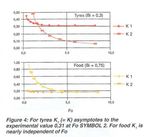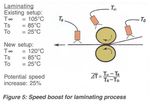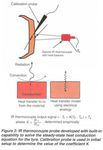ASPECTS OF INCREASED PRODUCTION SPEEDS VIA IR CONTROL OF PRODUCT INTERNAL TEMPERATURE
←
→
Page content transcription
If your browser does not render page correctly, please read the page content below
1/3
Dr. Frank Pompei
WHITEPAPER
ASPECTS OF INCREASED PRODUCTION SPEEDS VIA IR CONTROL OF
PRODUCT INTERNAL TEMPERATURE
„Infrared temperature measurement methods of production temperature; or the materials may have come from another
processes are limited to material surfaces, and thus have a process in the same plant, where the time it has been at
serious limitation in thermal process monitoring, particularly room ambient is unknown.
when considering speed increases. To overcome this
limitation, a heat balance equation is derived in which the Referring to Figure 1 it can be seen that if the initial bulk
material surface temperature data is combined with other temperature were known, the total time in an oven could
non-contact temperature data to calculate the internal be reduced by increasing conveying speed and adjusting
temperature of the product, which in turn is used to optimise oven temperature distribution. Without this temperature
control to increase speeds.“ information, the oven time must be sufficiently long to
accommodate the worst case initial condition. For non-
The model results are in agreement with experimental data metal, the surface temperature alone, which can be
in tyre manufacturing, where hundreds of actual installations obtained with infrared sensing devices, is not sufficient
of such non-contact systems are successfully increasing due to the large gradient from the material surface to the
tyre production speeds by optimising the vulcanising time interior. Accordingly, a more sophisticated technique is
to the initial conductions of the green tyre. The method is required which is based on easily measured variables, yet is
extended to any thermal process and examples for food robust enough to be used in real-world factory conditions.
processing, printing and laminating are given.
Empirical success with tyres
A common problem in thermal processing during production
is the lack of control of the initial condition of the materials
to be processed. For example, the storage of materials could
be in a cold or hot warehouse, the temperature may vary
depending on the climate and season; it could have just
been delivered by truck and there is no certainty as to bulk
A specific application for tyre vulcanising was actually
researched and installed at a major tyre manufacturer.
The process for tyre vulcanising is similar to the process
illustrated in Figure 1, expect that it is not continuous. Tyres
are ‘cooked’ under heat and pressure in special moulds, one
at a time, in individual presses. By measuring the ‘green’
tyre temperature immediately prior to vulcanising, press2/3
time could be adjusted to maximise throughput. This in turn Despite the success, the underlying analysis was largely
increases plant capacity with almost no capital investment – empirical, with no theoretical support for the simple steady-
a significant accomplishment compared to adding capacity state model, and thus there was considerable uncertainty as
to a $100 M plant conventionally. to whether the method may be applied to other processes,
or even to other tyre manufacturing plants.
Initial experimental work immediately indicated that
employing surface temperature alone would result in Accordingly, a more complete analytical model was required
unacceptable errors. Accordingly a method was proposed to provide the design parameters necessary for successful
that solved a simple steady-state heat balance equation applications, and to minimise the time and cost of empirical
at the tyre surface, and thus could provide the internal investigations in actual plants.
temperature with a simple non-contact device. This method
is described in Figure 2. Mathematical modeling
The model can be derived by constructing the unsteady
IR thermocouples with a heat balance circuit were differential equations governing heat conduction [1]. The
constructed and calibrated to the correct ‘K’ value as per form of the solution includes all of the attributes needed to
Figure 2. These were installed in the tyre plant (see Figure apply the problem of determining internal temperature by
3) with very good tracking of actual internal temperatures. non-contact measurement and a simple calculation:
Hundreds of tyre presses were placed under the control of - The coefficient K1 necessary to program the IR device is
this method, and for seven years they have produced with clearly identified (= K of Figure 2)
excellent results, increasing throughput by about 10%. This - The coefficient K2, which represents an uncontrolled initial
is especially effective in the summer when green tyres are condition error, is clearly identified
warmed by storage in hot warehouses prior to vulcanising. - The coefficients emerge with conventional dimensionless
heat transfer groups: the Fourier No (Fo) characteristic heat
conduction time, and Biot No (Bi) ratio of surface transfer
rate to conduction.
Figure 4 shows the variation of K2, K1 with Fo at the Bi
calculated for the thermally processed tyres, and for
comparison to feed. Note that the experimental value K –
0.31 is directly predicted.
Results of this analysis can be used to develop the speed
boost equation (SBE) which can then be used as a control
algorithm to maintain correctly balanced thermal input to
produce consistent product temperature profiles from the
surface to the center, at various speeds, V. for large speeds
changes, for example >10%, material and heat transfer
characteristics may become non-linear, and thus require re-
normalisation of the value of K2/K1 at more than one point
until the final desired speed is reached.
The physical interpretation of the SBE is that the ratio of
energy supplied by the heat source at T∞ to the product
with surface temperature Ts, divided by the energy level
difference between the initial state TO and final state Ts is to3/3
be held constant, and the speed is held constant, the initial Figure 7 is another example from the graphics industry,
and source temperatures must be controlled to maintain showing how the temporising roll in waterless printing may
the balance in the SBE. be controlled by using the SBE with the appropriate sensors.
Applying the SBE to laminating processes, as illustrated in
Figure 5, a 25% speed increase may be realised by increasing
the heating roll temperature from 105 to 120oC, holding
all else constant. The same increase could be achieved by
providing preheat to 48oC without changing the source
temperature.
Conclusion
Employing IR sensing to accurately control thermal
processing, especially to increase process speeds, must
include provisions for the difference between the surface
temperature, which can be directly measured, and the bulk
material temperature, which must be indirectly measured.
By employing a simple result of a complex mathematical
model, the bulk temperature can be estimated from surface
temperatures, ambient temperature, material properties
and speed. By extending the model, a result we call the
Figure 6 shows an example of a high speed colour copier SBE can be directly employed with appropriate IR sensors
which has as the heat source the fuser roll temperature. to increase production speeds while maintaining material
The product temperature is the copy itself and the initial temperature characteristics.
temperature is the feed paper. Inks for colour copies are
particularly temperature sensitive due to the strong viscosity
dependence on temperature. Here accurate control is very
important in order to maintain quality at maximum possible
speed (a highly competitive selling point for manufacturers).
Applying the SBE with appropriate IR sensors allows maximal
speeds under all conditions, especially if a preheat stage is
fitted to the design.
Exergen Global offices:
The Netherlands USA office@exergenglobal.com
Pastoor Clercxstraat 26 400 Pleasant Street www.exergenglobal.com
5465 RH Veghel Watertown, MA 02472
Tel: +31 (0)413 376 599 Tel: +1 617 649 6322
Fax: +31 (0)413 379 310 Fax: +1 617 923 9911 WP-503-EN-V2You can also read
























































